Affiliate disclosure: This post may contain affiliate links. Please see our Privacy Policy.
Elderberry plants can be expensive to buy, but it’s easy to grow elderberries from cuttings. All you need is a few hardwood cuttings taken in the late fall or winter and a bit of patience.
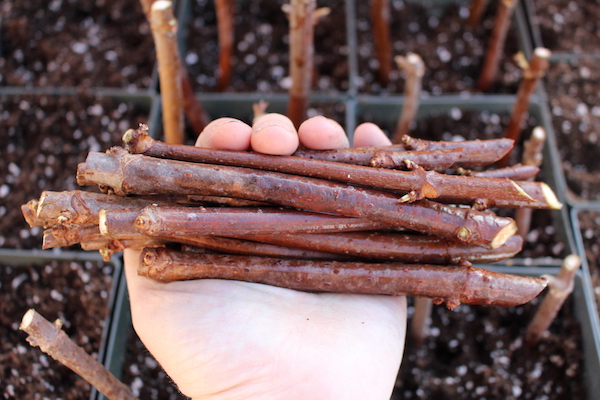
When my husband and I first moved to our off-grid homestead, elderberries were one of the very first things we planted. They’re a big part of our winter wellness strategy, and they go into all manner of tasty things like elderberry oxymel as a quick cough syrup, elderberry mead for long winter nights and even elderberry jelly that our little ones love.
Beyond that, elderflowers make delicious liqueur and they feed the bees, both domestic and native.

We stopped by the nursery and I just couldn’t believe how expensive elderberry plants were. They were $30 each, about the same price as grafted apple trees.
Now, a few years later apple trees are more than $60 each and I don’t even want to look at the price tags on elderberry bushes. Time for a different strategy.
While buying elderberry plants may be expensive, with a little work and patience you can grow elderberries from hardwood cuttings. We’ve had great success propagating grapes with cuttings taken in the winter months, so why not try propagating elderberries?
Our original elderberry plants are still pretty small, as they’re notoriously slow growing for the first few years after transplant. I didn’t want to take many cuttings from them, so instead I ordered elderberry cuttings from Norm’s Farm which ships them out in January each year. I ordered 30 cuttings, and they shipped 45 (Thanks!), so here I am potting up whole trays of elderberry cuttings in our sunny attached greenhouse in early February.
(Elderberries are only one of many fruits you can propagate from cuttings, including blueberries and grapes. They’re one of the easiest, and they sprout easily from hardwood cuttings.)
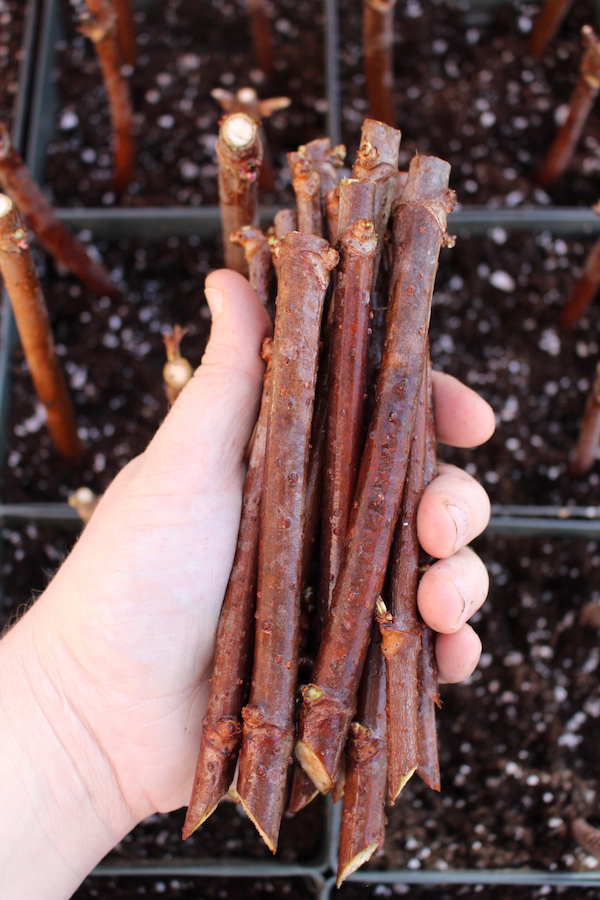
How to Grow Elderberries from Cuttings
If you’re taking your own cuttings, do it when the plants are dormant for the winter. Make a slanted cut on the “root” side of the cutting so that you plant them in the correct direction. If you forget, you can still look at the buds on the stick and see which direction they’re pointing before planting, but making a slanted cut during harvest saves a lot of time on the potting bench.
Elderberry cuttings should be about 6 to 8 inches long and include at least 4 buds.
Whether you’ve ordered elderberry cuttings online or cut them fresh from existing plants, the process is the same once they’re in hand. Start by soaking the cuttings in water for 24 hours to thoroughly rehydrate them. Then prepare a tray of pots with moistened potting soil.
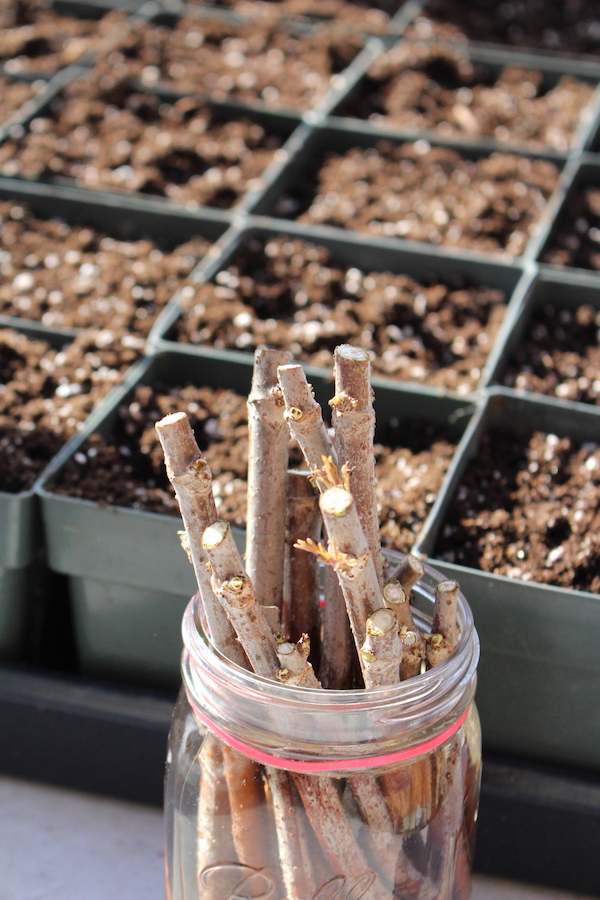
Since the elderberry cuttings have been soaking in water, the “root” end will be wet, which is perfect for dipping into a rooting hormone. I’m using a commercial rooting hormone powder, which is dependable and effective. It’s a synthetic version of the same hormone plants produce naturally.
You can also use willow water as a rooting hormone. Willows have a lot of natural rooting hormone, and soaking a few willow twigs in water helps to extract it for use with other plants. I imagine willow bark powder would also work as a natural alternative.
Dip the slant cut “root” end in the rooting hormone, covering the cutting about an inch up the sides.
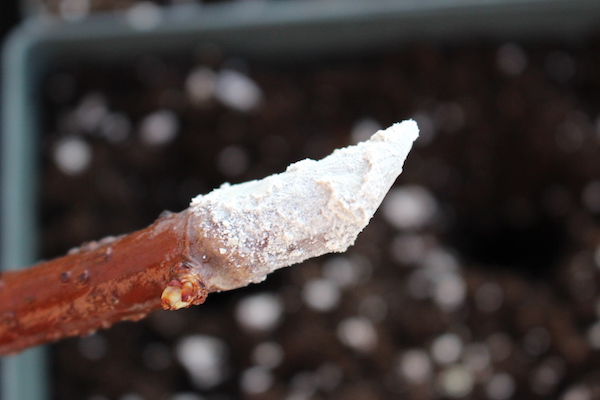
To plant, make a hole in the potting medium with your finger first. The whole is so the powder doesn’t get knocked off the elderberry cutting during planting, so don’t just slide the cutting into the soil. Then push the soil back around the cutting and tamp down.
You can reasonably plant 3-4 cuttings in a 5 to 6” pot. They’ll need to be transplanted to their own pot later in the spring, but this saves on space early on when not all the cuttings will survive.
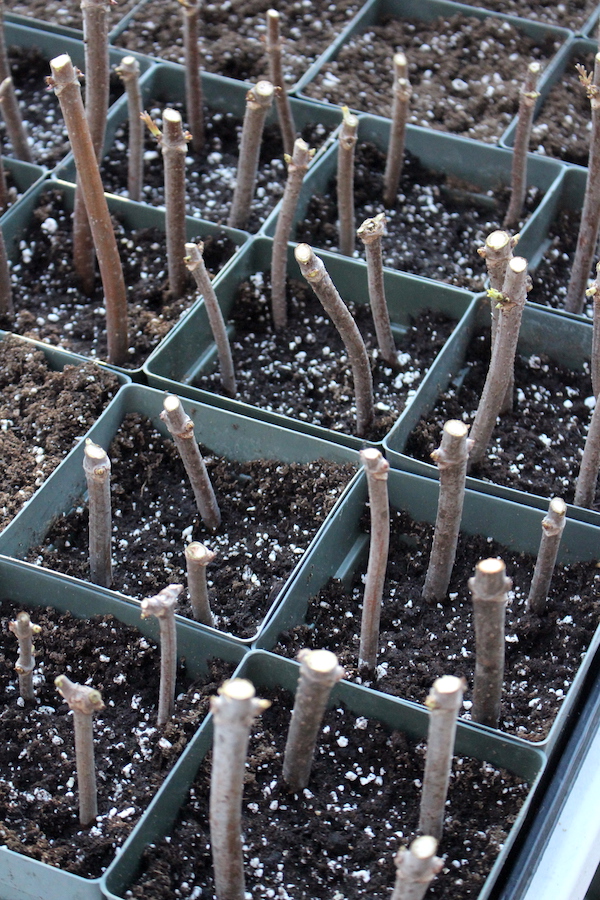
Once the elderberries are planted, it’s important to keep them cool (but not cold) to encourage root formation. The ideal is about 40 degrees F, out of direct sunlight and wind. Direct sunlight and warm temps encourage quick top growth, at the expense of good roots.
If you live somewhere with a mild winter, a sheltered outdoor location would work well. In our case, I think the high this week is a whopping 3 degrees, with high winds. We won’t see consistent 40-degree temps until April at least. My elderberry cuttings are going into the basement, which is about 50 degrees, but moist and semi-dark.

Keep the soil moist but not soggy and wait. Solid roots and new shoots should be present after 8 to 10 weeks. At that point, the elderberry cuttings (or tiny plants) can be potted up individually or planted out in the garden in spring.
When planting elderberries, be sure to give them plenty of space. They’ll stay small for the first few years, but mature plants can be 8 to 10 feet tall…

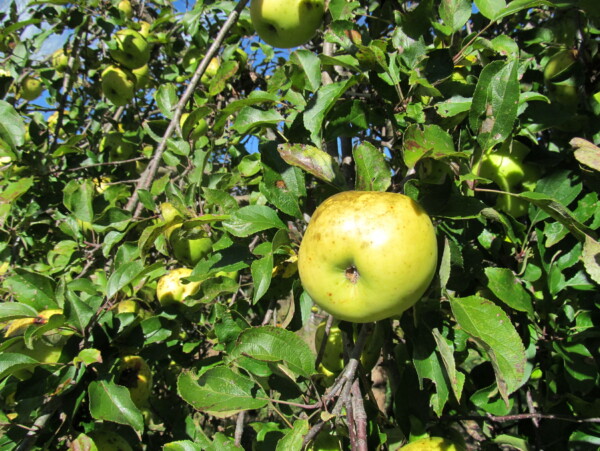
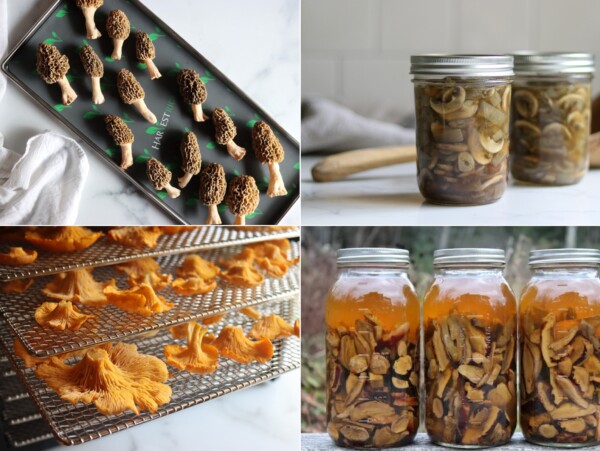
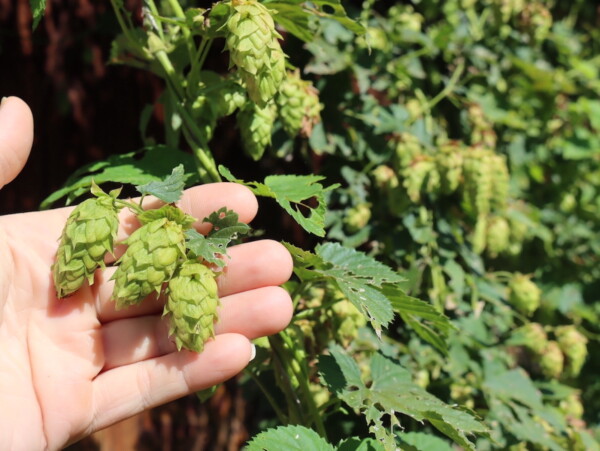
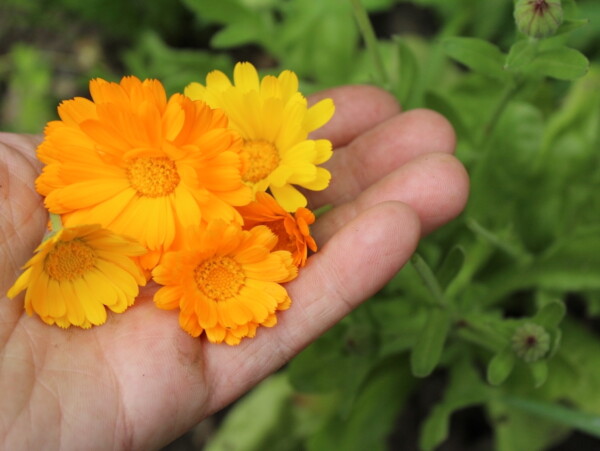
Thanks Ashley! Is the process pretty much the same for gooseberries?
Yes, it would be the same for any woody bush.
Thank you for sharing this great idea! I did discover an elderberry shrub this summer mixed in with raspberries. I wish I would have marked it with tape. I have no idea where it is now that all the leaves are off. Do you have any tips for identifying elderberry in the winter?
Probably one of the easiest ways to recognize elderberry are the knobby spots on the bark called lenticels.
Thank you for your info. I am currently trying to propagate some elderberry cuttings in my basement (from this article)! I would like to note that in this article you state that they are “slow growing” the first few years but when I read your March 2021 article “How to grow elderberries” you stated they are fast growing. Of course I’m hoping they are fast growing! But if they are not, that changes where I will be planting them. If they in fact ARE fast growing, maybe add that to this article as well in case someone doesn’t read your March 2021. Just looking for a little clarity as I’m new at this! Thank you!!
Sometimes, they do grow slowly during the first few years, but grow quickly and quite large once they are established. You definitely want to plant them in a spot where they have plenty of room to grow. You want them at least 4 to 6 feet apart. They will grow 5 to 8 feet tall and some even taller.
I live in upstate NY. Can I cut the shoots now in November and just keep them in my basement and the soak, root powder and plant in March?
If you cut them now, you will want to go ahead and get them planted in a container with some growing medium until you’re ready to put them in the ground.
Can the young plants be set in full sun after they have rooted and have leaves? BTW great article. Thanks
The main purpose for keeping them in cooler temperatures and out of direct sun is to encourage a strong root system as opposed to a lot of top growth. If the root system is strong then you should be fine to move them to direct sun. It might be a good idea to do this gradually much like you would a new seedling.
Once you have leaves on your elderberry twigs when do you move them to direct sun? They’ve been sheltered &. In the shade since I planted them. The leaves are probably at least 2 ” long at least. Thanks.
The main purpose for keeping them in cooler temperatures and out of direct sun is to encourage a strong root system as opposed to a lot of top growth. If the root system is strong then you should be fine to move them to direct sun. It might be a good idea to do this gradually much like you would a new seedling.
What a clever way to save money while still growing our homestead, I love it! I’m adding this to my to-do list. Thank you for sharing! 🙂
Beutiful story! I will definitely try.
What do you think about growing Actinidia from cuttings? I have soma Actinidias (both types) and wont to get some more.
I haven’t tried it, but a quick google search says it’s a similar process. Good luck!
i planted a cpl rooted cuttings 3 yrs ago.
the first yr they just looked like they survived
second yr they looked completely dead
i had given up completely
the following yr they came back like gang busters
huge florets but hardly any berries
also.. somehow a plant grew in front of my workshop door
at least 50 ft away from original plantings
i now have 3 volunteers at varying distances from the plantings
recently went a lady’s house and marveled at how she could grow japanese maples
she said not maples.. black beauty lace leaf elderberrys
its very leggy and I volunteered to prune it for her after dormancy
i will have dozens of cuttings from it
That’s really interesting, I’ve never heard of Black beauty lace leaf elderberries…I’m going to have to look those up. Thank you!
I understand there is a certain type of elderberry that is best for fighting virus infections…..does anyone know which type that is or do they all work as effectively for that purpose? Thanks to anyone who can shed light on my question.
Blue or black elderberry is highly medicinal and used to boost immunity.
Sambucus nigra
A wonderful website. Thanks for all you do. We have a lot of clay soil in a section of our property where I would like to cultivate elderberries. Should I amend the soil or plant elsewhere?
Ours are in clay soil and they do pretty well with it.
Yup. The Willamette Valley is almost all heavy clay soil, but our elderberries seem to flourish.
I loved this information! I live in the Willamette Valley in Oregon and we have two kinds of elderberries that grow wild in the coast range: red and blue. The red can give you a severe case of cramps and indigestion and are considered poison. The blue ––we all love those! Having purchased two blues from our high school plant sale, I tried propagating (with willow tea) this spring but after having read your article, Ashley, I know why they didn’t take: Our Oregon spring was mild and warm, and I didn’t make my cuttings till the end of February. The cuttings all put our leaves almost immediately, but after about a month, started dying off. No roots!! Next year I’m going to make my cuttings at the end of December or the first week of January. It will make a huge difference, not just temperature-wise, but at these latitudes the plants really are affected by the length of daylight, which is quite short in January. Here’s hoping for lots of roots!! By the way, here in Oregon we call them elderberry bushes, too. They have multiple stems, not like a tree trunk.
I had a young Elderberry plant that was about 2 ft tall. It was accidentally stepped on, and it snapped completely off at the base. Is there any way to salvage it? Will it grow back next year? Can I put the stalk in water or root solution to try and save it?
It will most likely come back from the root (maybe even later this year) if it was a healthy plant. You can put the broken part in water and/or rooting solution and try to root it. Elderberry generally roots quite easily, and it may well take root even with less than optimal timing. Best of luck!
We bought an old homestead two years ago. The trees and shrubs were neglected for 4-5 years previously. Being on the Alberta prairies, means that existing plants have survived winters of -40, summers of +40 degrees C, strong winds and drought. Caragana, lilac and one lone elderberry bush were planted as part of a shelter belt. Also poplar, pine, maple and a horrid apple tree. I cut branches from the elderberry 6 weeks ago, started them like the author suggests, and now there are tiny buds forming. I haven’t checked for roots, but I’m hopeful. The elderberry bush/shrub is 12 feet high and 8 feet wide and a few more of them growing here would be beneficial. Thanks for all the tips.
I think it’s totally weird that you’re calling them elderberry plants! It’s an Elder tree for goodness sakes! Is there a special reason? You refer to Apple trees in your article… why not apple plants?
What do you call it when it gas flowers on it? An elderflower plant? No it’s an Elder tree just like any other fruit tree, it has flowers/blossom in the spring and then fruit in the autumn.. so readers are clearly puzzled by this term, I think you’re misleading folk… an elderflower tree will grow between 15/20 foot high… they can cope with cold temperatures.. Germany eg grows them commercially for the blossom, they like their elderflower liqueurs, so they cope well with cold winters but equally well with warm/hot summers…they’re a very common wild hedgerow tree right across Europe…
In the US, for whatever reason, they’re called bushes and people would be just as confused here if someone called them elder trees. The same language, technically, but usage is often really different.
Technically the common Elder S canadensis is a deciduous shrub. It’s most often more of a bush form than tree but I have seen some that are large enough to be called trees. S nigra in Europe and S nigra caerulea, the Blue Elderberry along the West coast of the US into Texas get very large and don’t put out a lot if any root shoots as S canadensis. People who have only ever seen the Blue Elderberry may consider them trees.
I sent off for some cuttings from MO but, found one in the wild here in the central highlands of Arizona. I took some cuttings a week ago…they already had leaves coming out. I put rooting hormone on them and tented them in plastic and pulled off some of the leaves. I really hope they’ll make it since the bush is located off the Great Western Trail here and is likely very old. I know you said to make the cuttings in winter but, worth a try!
After transplanting the rooted cuttings in the ground, do they have to be protected from deer and rabbit, and if so for how long? Thanks!
They’d have to be protected from deer and rabbits until they’re fully established and rather large honestly.
We live in Pennsylvania. We have a few elderberry bushes but would like some more. What is the season for doing the propagation by cuttings? March-August?
Cuttings need to be taken when the plants are dormant, and then potted up when temps are quite cool in the early spring. In the pacific northwest where we bought out cuttings, they take them in January. That’s a little early for us, since it’s so cold outside at that time. We had to pot them up in our basement. For our Vermont climate, taking cuttings in late March would be ideal. Before bud break, but when temps are a bit milder.
Down in PA, I’d guess you’d need to take cuttings in Jan/Feb, but that’s a guess.
Gosh, I am counting myself very fortunate that I have elderberry growing like a weed on my property! I love my magical elderberry bushes and use the flowers and berries. By the way, I live in the U.K.
Why do you call them elderberry bushes? The Elder is one of the uks most common hedgerow trees
There are elderberry bushes and elderberry trees, depends on the variety
What kind of soil and location do elderberries need?